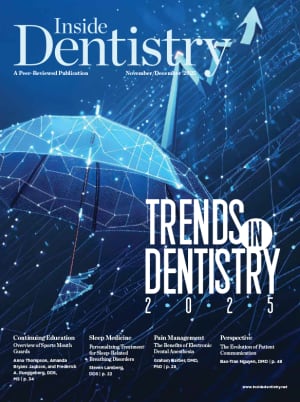There are many things that you could accuse dentistry of, but lacking innovation isn't one of them. In our May cover story, Inside Dentistryexamines the use of lasers in clinical practice-an area of the profession that is ripe with innovation. Although the incorporation of lasers into clinical dentistry began with a handful of soft- and hard-tissue applications for restorative and surgical procedures, it has proliferated into virtually every aspect of practice. As you'll learn in the article, lasers are being used for periodontal treatment, root canal disinfection, biopsy, caries removal, tooth etching, gingivectomy, frenectomy, photodynamic therapy, treating oral lesions, photobiomodulation for treating TMJ and improving postsurgical healing, and even for treating sleep-disordered breathing. The development of new applications for lasers seems limitless.
Personally, I use a diode laser in my practice for soft-tissue applications, primarily for gingival sculpting and troughing, exposing implant healing caps, etc. But I have to admit that I'm sometimes a little jealous of dentists who have implemented hard-tissue lasers into their practices because among their other myriad uses, hard-tissue lasers can be used to soften the resin of bonded porcelain veneers or crowns, which allows them to be popped right off, eliminating the need for tedious grinding that could also result in the removal of healthy tooth structure.
In our May continuing education offering, we see a simpler example of innovation in dentistry with the use of copper bands as adjunctive restorative matrices. This article brought me back to when copper bands were used 30 years ago for impression-making and other purposes. Because of the malleability of copper bands and their ability to facilitate retraction, dentists would place them around prepared teeth, directly fill them with wax, and use the wax patterns to cast gold inlays. In this month's CE, Zadeh and Karimi explain how the adaptability of copper bands can be leveraged in a matrix-in-matrix technique to improve isolation and achieve highly precise restorations in cases with deep margins or complex tooth morphology. It's a great solution.
Whether it involves advanced new technology or just a new twist on an old favorite, dentistry is always showing its ability to innovate to improve outcomes for patients!
Robert C. Margeas, DDS
Editor-in-Chief, Inside Dentistry
Private Practice, Des Moines, Iowa
Adjunct Professor • Department of Operative Dentistry
University of Iowa, Iowa City, Iowa
robert.margeas@conexiant.com
